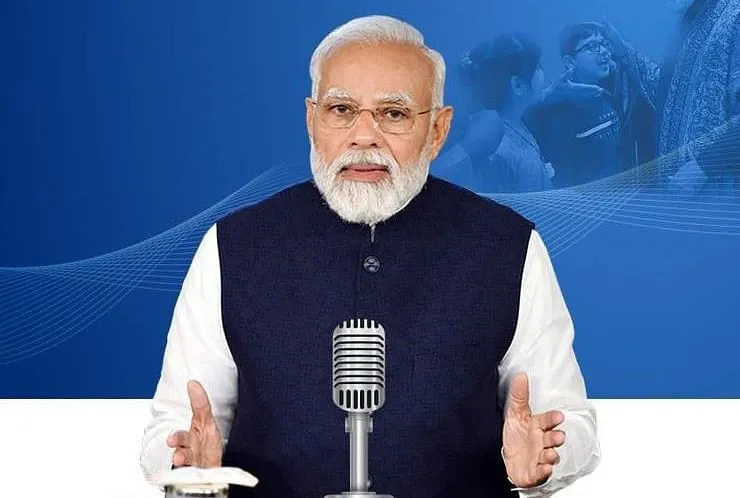Prime Minister Narendra Modi addressed the nation on the 75th anniversary of Independence Day from the ramparts of the Red Fort in Delhi. That has been the traditional and fitting venue from where Indian Prime Ministers raise the tricolour on Independence Day anniversaries and speak to the people of their policies and vision for the country. The Red Fort that Shah Jahan built has seen much history since it was completed in 1648. It has a special place in modern Indian history too.
Mangal Pandey lit the first spark in the war of independence at Barrackpur in March 1857. In his address Modi rightly included his name among those who fought to break British bondage. As the news of Pandey’s heroism and sacrifice spread the Indian soldiers of the East India Company stationed at Meerut took decisive action two months later and rebelled against the Firanghis. From Meerut they headed to the Red Fort and appealed to the Mughal Emperor Bahadur Shah Zafar, as they sought to break the chains of servitude.
Almost nine decades later, it was also at the Red Fort, that the British army tried officers of the Indian National Army (INA) who had shown great courage under Netaji Subhas Chandra Bose’s leadership to fight for freedom. The INA trial conducted in 1945 had magnetically captured the attention of the Indian people, invigorated the fervour for freedom, as the British empire in India took its last gasps. And, now every August 15 all Indians turn their attention to the fort to hear the views of the person who on that day holds their mandate for governance and leadership.
Modi’s address this special year covered a vast array of issues which currently confront the country. It also gave a roadmap for the next twenty-five years. This is what is required of national leaders because even as they focus on present matters and problems, they have to instil confidence among the people about the future. Speaking of the present times Modi emphasised the need for a national spirit of commitment to comprehensive progress. Particularly relevant for national advance was his emphasis on the need for research and innovation. He said that while Prime Minister Lal Bahadur Shastri had emphasised “Jai Jawan and Jai Kisan” and Prime Minister Atal Bihari Vajpayee had added the words “Jai Vigyan” to them, he would like to add “Jai Anusandhan”. Taken together they point the nation to focus on security, agriculture, science, research and innovation. Also, while doing so, honour those who in are engaged in these endeavours.
The key to both national defence and agricultural advance which would give food security lies in science, technology and innovation. It is good that Modi recalled Vajpayee’s emphasis on scientific development but the Indian leader who had a clear vision of the need for modern India to be in the frontier areas of science was Jawaharlal Nehru. It was he who laid the foundations of the scientific and technological infrastructure of the country which has produced gradually, but in ever increasing numbers, a large cadre of world class technologists and scientists. But there is now need for much greater investments in this field because of the bewildering pace of advances in the digital age.
Modi shows that he is conscious of this need; hence, his stress on research and innovation. His emphasis on India reaching a stage when it could set standards in the area of technology was inspiring. Indeed, it is only when the country is able to achieve this position that it will be counted in the first rank of nations. In this context the Indian private sector has a great role to play for major industrial groups should invest far more than they doing now in research and innovation. That noted, the state will not be able to give up its responsibility to reinvigorate all of India’s scientific and technological institutions.
Another point Modi mentioned deserves special mention. He spoke eloquently of the need for gender equality and the need to respect women and their role in upholding family values. Even more, he stressed that for the nation’s progress women will have to play a far greater role in national life. Many economists insist that unless young women in very large numbers enter the work force India’s dream of becoming a developed nation will not be achieved. For this purpose traditional patriarchal social attitudes will need to change. It is good that Modi pointed out the coarseness that is now being witnessed in social behaviour and is reflected in the language of daily discourse. As Modi said “…it hurts me to say that we have witnessed a perversion in our day-to-day speaking, behaviour. We have been casually using language and words that are insulting to women. Can we not pledge to get rid of everything in our behaviour, culture and everyday life that humiliates and demeans women? Women’s pride is going to be a huge asset in fulfilling the dreams of the nation. I see this power and therefore I am insistent on it”. Modi’s call to society has to be reflected not only in language but also in the actions of society and of the governmental machinery at all levels. Most importantly, those who commit crimes against women should never be forgiven. State discretion should not be applied in their favour.
Above all every Independence Day is a reminder that those who gave their all in the cause of national freedom did so in the hope that independent India would be an inclusive, humane, progressive and caring society. That was especially the dream of the father of our nation.
Disclaimer: The views and opinions expressed in this article are the personal opinions of the author. The facts, analysis, assumptions and perspective appearing in the article do not reflect the views of GK.







